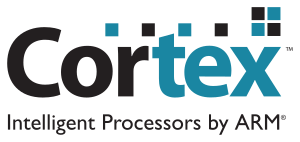From WikiChip
Difference between revisions of "arm holdings/cortex"
(cortex) |
|||
| Line 1: | Line 1: | ||
{{armh title|Cortex}}[[File:arm cortex logo.svg|thumb|right|class=wikichip_ogimage|Logo]] | {{armh title|Cortex}}[[File:arm cortex logo.svg|thumb|right|class=wikichip_ogimage|Logo]] | ||
'''Cortex''' is a family of specialized [[ARM]] [[microarchitectures]] designed by [[Arm]] for various edge market such as embedded and mobile. The Cortex family succeed Arm's {{\\|classic}} cores with more specialized cores with highly targeted requirements | '''Cortex''' is a family of specialized [[ARM]] [[microarchitectures]] designed by [[Arm]] for various edge market such as embedded and mobile. The Cortex family succeed Arm's {{\\|classic}} cores with more specialized cores with highly targeted requirements | ||
| + | |||
| + | == Overview == | ||
| + | Cortex is a family of [[ARM]] cores that address a broad set of markets. First announced in 2004, Cortex cores have replaced [[Arm]]'s {{\\|classic}} cores with more market-specific variations. Cortex can be broadly categorized into three types of workloads: Applications, Real-time, Microcontroller (A.R.M). | ||
| + | |||
| + | * '''Cortex-A''' - '''Application processors'''. Designed for fully capable computers, running typical operating systems (Android, Windows, Linux, iOS). Those processors are found in anything from smartphones to tablets and laptops. | ||
| + | * '''Cortex-R''' - '''Real-time processors'''. Designed for real-time operating systems with very deterministic behavior. Those cores are typically less powerful than the A series and are used for things such as controllers, factory equipment, medical devices, and other machines. | ||
| + | * '''Cortex-M''' - '''Microcontrollers'''. Designed for ultra-low power, typically small factor and low-performance systems. Those are found in cost-sensitive devices and electronics, automated systems, and many other embedded devices. | ||
| + | |||
{{stub}} | {{stub}} | ||
[[category:arm holdings]] | [[category:arm holdings]] | ||
Revision as of 01:51, 31 December 2018
Cortex is a family of specialized ARM microarchitectures designed by Arm for various edge market such as embedded and mobile. The Cortex family succeed Arm's classic cores with more specialized cores with highly targeted requirements
Overview
Cortex is a family of ARM cores that address a broad set of markets. First announced in 2004, Cortex cores have replaced Arm's classic cores with more market-specific variations. Cortex can be broadly categorized into three types of workloads: Applications, Real-time, Microcontroller (A.R.M).
- Cortex-A - Application processors. Designed for fully capable computers, running typical operating systems (Android, Windows, Linux, iOS). Those processors are found in anything from smartphones to tablets and laptops.
- Cortex-R - Real-time processors. Designed for real-time operating systems with very deterministic behavior. Those cores are typically less powerful than the A series and are used for things such as controllers, factory equipment, medical devices, and other machines.
- Cortex-M - Microcontrollers. Designed for ultra-low power, typically small factor and low-performance systems. Those are found in cost-sensitive devices and electronics, automated systems, and many other embedded devices.
| This article is still a stub and needs your attention. You can help improve this article by editing this page and adding the missing information. |
